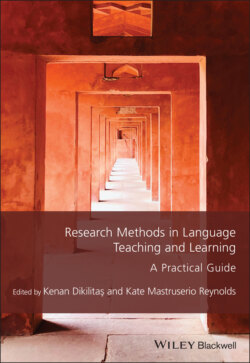Читать книгу Research Methods in Language Teaching and Learning - Группа авторов - Страница 38
Decisions About Data Analysis
ОглавлениеAs the discussion throughout the chapter has shown, the ways in which I conceptualized the data collection process, my decisions underpinning diary design, and the ways in which I communicated with and related to the research participants shaped the resultant data; as Richards et al. (2012, p. 33) note about ethnographic research in general, I was “the primary research instrument” in my project.
My analysis needed to make sense of participants’ “lifeworlds” in order to represent their subjective, insider representations of their classroom and in-class events (see also, Blommaert & Jie, 2010). Consequently, my analysis was necessarily interpretive, as I sought to both “believe” and “doubt” what the data was telling me (Bailey, 1991). This involved identifying the participants’ “truths” through themes and categorizations,which emerged from the data itself, while at the same time acknowledging any difficulties around the diarists’ recruitment and participation, and, consequently, the data they provided – for example, was the study subject to recruitment bias? Did the participants vary in their attitudes to self-disclosure, and did individual diarists’ data differ in length and detail, giving some participants more “voice” in the study than others; if so, how should this data be treated? (Bolger et al., 2003).
Consequently, my analysis needed go beyond the “list-making” activity of solely categorizing data to identify a conceptual framework, which recurrent themes within the data would illuminate (Pavlenko, 2007). In the study, therefore, my framework for interpreting the data was my conceptualization of the classroom as a socially constructed environment (see “Introduction”). Subsequently, although there were a range of ways in which I could approach and analyze the data (ranging from, for example, content analysis to conversational or narrative analysis), I did not start the analysis with a series of pre-determined themes and categorizations in mind that I then attempted to identify. Rather, I pursued a data-led Grounded Theory approach in which patterns and categorizations within the data emerged during the analysis. Such emergent themes included, for example, learners’ deliberate underperformance and the role of silence during class (i.e., some learners were reluctant to answer the teacher’s questions during all-class plenary sessions even though they knew the answers, because they were embarrassed at speaking in public or did not want to be labeled a “know-it-all” by others); apparent inconsistencies in the teacher’s treatment of some learners’ enquiries (i.e., some learners’ difficulties were dealt with in more detail and at much greater length than others, dependent on, as the teacher saw it, the level of detail a particular learner required balanced against the needs, interest, and in-class motivation/boredom of other students); and the ways in which potentially problematic “moments” of interaction were smoothed over by all participants (i.e., all participants seemed to appreciate the need for a balance between developing their full understanding in a language classroom at moments of communicative difficulty and breakdown and the need for lessons to at some point “move on,” even when some had not fully grasped the language being presented, discussed, or practiced). In each case, therefore, the data revealed regular patterns of behavior in lessons that, while clearly affecting language learning opportunities, had its origins in the participants’ understanding of the classroom as a social environment underpinned by shared social norms.
Throughout this process of data interpretation and analysis, I was aware that my interpretation of the diary data might differ from that of another investigator or data analyst – as a researcher, I was inseparable from the findings that emerged. In order to lessen the risk of particularly partial or idiosyncratic interpretations, I therefore engaged in a process of “respondent validation” (Richards et al., 2012) with the project’s diarists, in which I shared and checked my interpretation of the data and, thus, the classroom, with them, and triangulated my understanding of themes within the diary data with those that emerged during my interviews with the participants.
